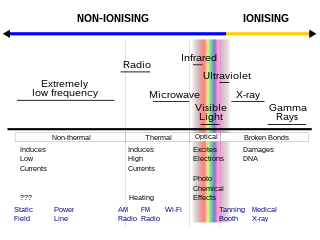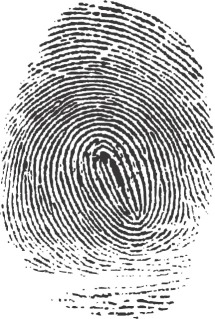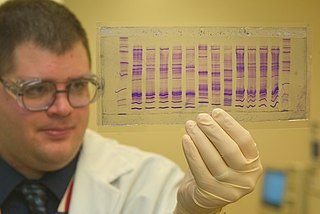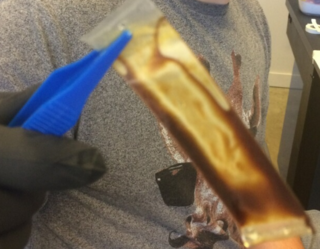Related Research Articles

Ultraviolet (UV) is a form of electromagnetic radiation with wavelength shorter than that of visible light, but longer than X-rays. UV radiation is present in sunlight, and constitutes about 10% of the total electromagnetic radiation output from the Sun. It is also produced by electric arcs; Cherenkov radiation; and specialized lights, such as mercury-vapor lamps, tanning lamps, and black lights.

Electromagnetic radiation can be classified into two types: ionizing radiation and non-ionizing radiation, based on the capability of a single photon with more than 10 eV energy to ionize atoms or break chemical bonds. Extreme ultraviolet and higher frequencies, such as X-rays or gamma rays are ionizing, and these pose their own special hazards: see radiation poisoning.

Forensic science, also known as criminalistics, is the application of science principles and methods to support legal decision-making in matters of criminal and civil law.

A fingerprint is an impression left by the friction ridges of a human finger. The recovery of partial fingerprints from a crime scene is an important method of forensic science. Moisture and grease on a finger result in fingerprints on surfaces such as glass or metal. Deliberate impressions of entire fingerprints can be obtained by ink or other substances transferred from the peaks of friction ridges on the skin to a smooth surface such as paper. Fingerprint records normally contain impressions from the pad on the last joint of fingers and thumbs, though fingerprint cards also typically record portions of lower joint areas of the fingers.

A blacklight, also called a UV-A light, Wood's lamp, or ultraviolet light, is a lamp that emits long-wave (UV-A) ultraviolet light and very little visible light. One type of lamp has a violet filter material, either on the bulb or in a separate glass filter in the lamp housing, which blocks most visible light and allows through UV, so the lamp has a dim violet glow when operating. Blacklight lamps which have this filter have a lighting industry designation that includes the letters "BLB". This stands for "blacklight blue". A second type of lamp produces ultraviolet but does not have the filter material, so it produces more visible light and has a blue color when operating. These tubes are made for use in "bug zapper" insect traps, and are identified by the industry designation "BL". This stands for "blacklight".

Ninhydrin (2,2-dihydroxyindane-1,3-dione) is an organic compound with the formula C6H4(CO)2C(OH)2. It is used to detect ammonia and amines. Upon reaction with these amines, ninhydrin gets converted into deep blue or purple derivatives, which are called Ruhemann's purple. Ninhydrin is most commonly used to detect fingerprints in forensic cases, as the terminal amines of lysine residues in peptides and proteins sloughed off in fingerprints react with ninhydrin.

Forensic toxicology is a multidisciplinary field that combines the principles of toxicology with expertise in disciplines such as analytical chemistry, pharmacology and clinical chemistry to aid medical or legal investigation of death, poisoning, and drug use. The paramount focus for forensic toxicology is not the legal implications of the toxicological investigation or the methodologies employed, but rather the acquisition and accurate interpretation of results. Toxicological analyses can encompass a wide array of samples. In the course of an investigation, a forensic toxicologist must consider the context of an investigation, in particular any physical symptoms recorded, and any evidence collected at a crime scene that may narrow the search, such as pill bottles, powders, trace residue, and any available chemicals. Armed with this contextual information and samples to examine, the forensic toxicologist is tasked with identifying the specific toxic substances present, quantifying their concentrations, and assessing their likely impact on the individual involved.
PUVA is an ultraviolet light therapy treatment for skin diseases: vitiligo, eczema, psoriasis, graft-versus-host disease, mycosis fungoides, large plaque parapsoriasis, and cutaneous T-cell lymphoma, using the sensitizing effects of the drug psoralen. The psoralen is applied or taken orally to sensitize the skin, then the skin is exposed to UVA.

Trace evidence is created when objects make contact, and material is transferred. This type of evidence is usually not visible to the eye and requires specific tools and techniques to be obtained. Due to this, trace evidence is often overlooked, and investigators must be trained to detect it. This type of evidence can link a victim to suspects and a victim or suspect to the crime scene.
Forensic identification is the application of forensic science, or "forensics", and technology to identify specific objects from the trace evidence they leave, often at a crime scene or the scene of an accident. Forensic means "for the courts".
Phosgene oxime, or CX, is an organic compound with the formula Cl2CNOH. It is a potent chemical weapon, specifically a nettle agent, which is a type of blister agent. The compound itself is a colorless solid, but impure samples are often yellowish liquids. It has a strong, disagreeable and irritating odor. It is used as a reagent in organic chemistry.

Forensic chemistry is the application of chemistry and its subfield, forensic toxicology, in a legal setting. A forensic chemist can assist in the identification of unknown materials found at a crime scene. Specialists in this field have a wide array of methods and instruments to help identify unknown substances. These include high-performance liquid chromatography, gas chromatography-mass spectrometry, atomic absorption spectroscopy, Fourier transform infrared spectroscopy, and thin layer chromatography. The range of different methods is important due to the destructive nature of some instruments and the number of possible unknown substances that can be found at a scene. Forensic chemists prefer using nondestructive methods first, to preserve evidence and to determine which destructive methods will produce the best results.

Gunshot residue (GSR), also known as cartridge discharge residue (CDR), gunfire residue (GFR), or firearm discharge residue (FDR), consists of all of the particles that are expelled from the muzzle of a gun following the discharge of a bullet. It is principally composed of burnt and unburnt particles from the explosive primer, the propellant (gunpowder), and vaporized lead. The act of firing a bullet incites a very violent explosive reaction that is contained within the barrel of the gun, which can cause the bullet, the barrel, or the cartridge to become chipped. Meaning gunshot residue may also included metal fragments from the cartridge casing, the bullets jacket, as well as any other dirt or residue contained within the barrel that could have become dislodged.

Ultraviolet germicidal irradiation (UVGI) is a disinfection technique employing ultraviolet (UV) light, particularly UV-C (180-280 nm), to kill or inactivate microorganisms. UVGI primarily inactivates microbes by damaging their genetic material, thereby inhibiting their capacity to carry out vital functions.

Forensic polymer engineering is the study of failure in polymeric products. The topic includes the fracture of plastic products, or any other reason why such a product fails in service, or fails to meet its specification. The subject focuses on the material evidence from crime or accident scenes, seeking defects in those materials that might explain why an accident occurred, or the source of a specific material to identify a criminal. Many analytical methods used for polymer identification may be used in investigations, the exact set being determined by the nature of the polymer in question, be it thermoset, thermoplastic, elastomeric or composite in nature.

Full-spectrum photography is a subset of multispectral imaging, defined among photography enthusiasts as imaging with consumer cameras the full, broad spectrum of a film or camera sensor bandwidth. In practice, specialized broadband/full-spectrum film captures visible and near infrared light, commonly referred to as the "VNIR".
Forensic serology is the detection, identification, classification, and study of various bodily fluids such as blood, semen, saliva, and urine, and their relationship to a crime scene. A forensic serologist may also be involved in DNA analysis and bloodstain pattern analysis. Serology testing begins with presumptive tests which gives the analyst an indication that a specific bodily fluid may be present, but cannot completely confirm its presence. Following the presumptive tests, confirmatory tests are done on the same sample to confirm what the unknown substance actually is.

Glove prints, also sometimes described as gloveprints or glove marks, are latent, fingerprint-like impressions that are transferred to a surface or object by an individual who is wearing gloves.

Forensic firearm examination is the forensic process of examining the characteristics of firearms or bullets left behind at a crime scene. Specialists in this field try to link bullets to weapons and weapons to individuals. They can raise and record obliterated serial numbers in an attempt to find the registered owner of a weapon and look for fingerprints on a weapon and cartridges.

A stabilized liquid membrane device or SLMD is a type of passive sampling device which allows for the in situ, integrative collection of waterborne, labile ionic metal contaminants. By capturing and sequestering metal ions onto its surface continuously over a period of days to weeks, an SLMD can provide an integrative measurement of bioavailable toxic metal ions present in the aqueous environment. As such, they have been used in conjunction with other passive samplers in ecological field studies.
References
- ↑ Ultraviolet Detection of Metal Traces - Trace Metal Detection Technique - Final Report; J.O.Rhoads; Minnesota Dept of Public Safety State Highway Patrol; 1971; http://www.ncjrs.gov/app/publications/abstract.aspx?ID=34019
- ↑ Honolulu CSI: An Introduction to Forensic Science and Criminal Investigation; p. 39; Gary A. Dias and Robbie Dingeman, cy 2004, Bess Press, Inc.
- ↑ "Gunshot Injuries" by Vincent J.M. DiMaio from the Elsevier Series in Practical Aspects of Criminal and Forensic Investigations, Elsevier Publishing Company (October 1989); pp 267-283.
- ↑ Trace Metal Detection Technique (TMDT) - A Report Outlining a Procedure for Photographing Results in Color, and Some Factors Influencing the Results in Controlled Laboratory Tests; J.M.Stevens; H.Messler; Journal of Forensic Sciences; Volume:19 Issue: 3: JULY 1974; Pages:496-503
- ↑ Study of the Use of 2-Nitroso-1-Naphthol as a Trace Metal Detection Reagent, C W Kokocinski; D J Brundage; J D Nicol; 1980; http://www.ncjrs.gov/app/publications/abstract.aspx?ID=73257